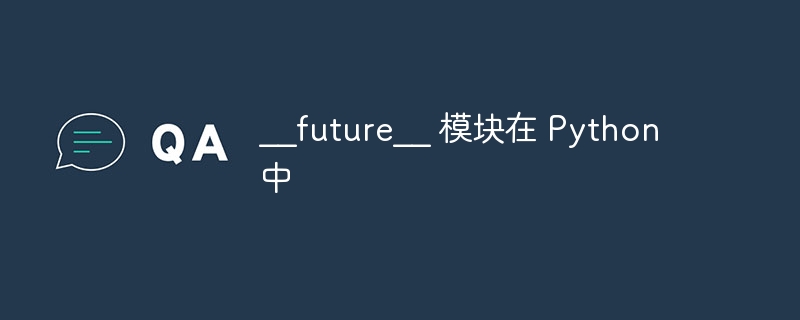

As a programmer, have you ever felt like you were destined to explore the exciting features of a new version of your favorite programming language? Well, if you are a Python lover, you are in luck! The future module in Python is here to give you a taste of destiny, or at least a preview of upcoming features. In this article, we'll embark on a journey together to explore the ins and outs of the Destiny module in Python and how it allows us to stay ahead of the game while still maintaining compatibility with older versions.
Before we delve into the intricacies of the Futures module, let’s first introduce what it is. The future module is an included Python module that allows programmers to apply new language skills that may be incorporated into upcoming Python versions. By uploading this module, you can write more future-proof code, allowing you to seamlessly transition to more modern Python variants without compatibility issues.
Python’s philosophy, as stated in Python Zen, emphasizes the importance of code readability and simplicity. As the language evolves, new features and syntax improvements emerge to make the programmer's life less complicated. However, this evolution sometimes leads to compatibility issues between different Python versions.
This is the highlight of the future module. It helps bridge the gap between special Python versions by allowing you to apply new language features before they are officially included in a general distribution. This way you can write more modern and maintainable code while still being well suited for older versions of Python.
Now that we have the basics down, let’s see what’s in store for future modules! To use it, all you need to do is import the unique functionality you need to apply from the future module. Here is an example of how you can import and use the "department" functionality from a future module -
Step 1−Import the "division" function from the future module.
Step 2−Perform the division operation (5 divided by 2) and store the result in the "result" variable.
Step 3−Print the value of the "result" variable, which is 2.5.
from __future__ import division result = 5 / 2 print(result)
2.5
Now that we know how to use the future module, let’s take a look at some of its most awesome features -
print_function−In Python 2, "print" is an assertion, while in Python 3, "print" is a feature that requires parentheses . By importing the print_function attribute, you ensure that your code matches well with Python 2 and Python 3.
from __future__ import print_function print("Hello, future!")
Hello, future!
absolute_import−By default, Python 2 appears to look for packages and modules in the frontier list before looking at the standard library. This may cause sudden behavior. The Absolute_import function forces the use of absolute imports, making your code more robust and predictable.
from __future__ import absolute_import import my_module
unicode_literals−Python 2 uses ASCII strings by default, while Python 3 uses Unicode strings. The unicode_literals feature enables Python 2 to handle string literals such as Unicode, making your code more stable across different Python variants.
第 1 步−从 future 模块导入“unicode_literals”特征。
第 2 步−创建一个包含值“Hello, World!”的字符串变量“text”。
第 3 步−打印“text”变量的类型。通过导入“unicode_literals”,Python 2 中将是
from __future__ import unicode_literals text = "Hello, World!" print(type(text))
生成器−Python 2.2 引入了生成器函数,但语法与我们今天所知的不同。生成器功能允许您在 Python 2.2 及更高版本中使用现代生成器函数语法。
第 1 步−从 future 模块导入“生成器”特征。
第 2 步−定义一个名为“my_generator”的生成器函数,它迭代从 0 到 4 的多个数字(总共 5 个数字)。
第 3 步−在生成器函数中使用“yield”关键字可以逐个返回范围内的每个数量。
第 4 步−迭代通过“my_generator”函数生成的值,使用 for 循环,并打印每个值。
from __future__ import generators def my_generator(): for i in range(5): yield i for value in my_generator(): print(value)
0 1 2 3 4
现在我们已经讨论了未来模块的一些关键功能,是时候讨论一些好的实践以确保您充分利用它了 -
在文档开头使用未来导入−为了确保代码中某个阶段的一致性,最好在文件的开头从未来模块导入首选功能。
对导入有选择性−仅导入您建议应用的功能。导入不必要的函数会使您的代码更难以阅读和理解。
使用几个 Python 版本测试您的代码−在特定的 Python 环境中测试您的代码以确保其真正成功运行并保持兼容性至关重要。
密切关注 Python 的发行说明−Python 的发布说明将告知您未来将带来的新功能。及时了解这些调整将有助于您编写更多的未来证据代码。
在本文中,我们深入研究了 Python 中 future 模块的迷人全局。通过将此模块合并到您的代码中,您将能够享受即将推出的 Python 函数的好处,同时保留与旧版本的兼容性。此外,您可以更好地组织过渡到更新的 Python 版本(因为它们最终出现)。因此,拥抱命运,让命运模块帮助您编写更现代、可维护且向前兼容的 Python 代码。快乐编码!
The above is the detailed content of __future__ module in Python. For more information, please follow other related articles on the PHP Chinese website!




